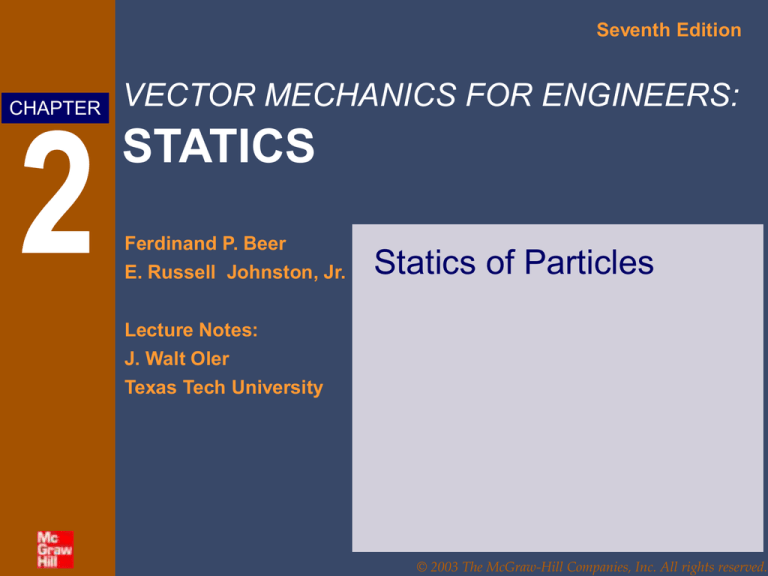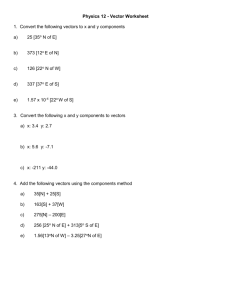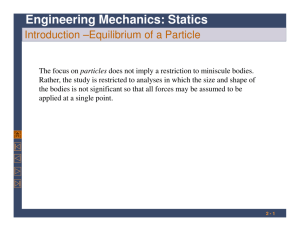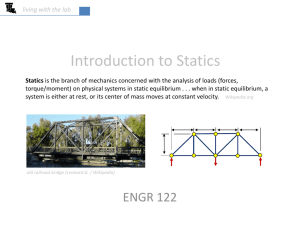
Seventh Edition
2
CHAPTER
VECTOR MECHANICS FOR ENGINEERS:
STATICS
Ferdinand P. Beer
E. Russell Johnston, Jr.
Statics of Particles
Lecture Notes:
J. Walt Oler
Texas Tech University
© 2003 The McGraw-Hill Companies, Inc. All rights reserved.
Seventh
Edition
Vector Mechanics for Engineers: Statics
Contents
•
•
•
•
•
Introduction
Resultant of Two Forces
Vectors
Addition of Vectors
Resultant of Several Concurrent
Forces
• Sample Problem 2.1
• Rectangular Components of a
Force: Unit Vectors
• Addition of Forces by Summing
Components
•
•
•
•
•
•
© 2003 The McGraw-Hill Companies, Inc. All rights reserved.
Sample Problem 2.3
Equilibrium of a Particle
Free-Body Diagrams
Sample Problem 2.4
Sample Problem 2.6
Rectangular Components in Space
2-2
Seventh
Edition
Vector Mechanics for Engineers: Statics
Introduction
• The objective for the current chapter is to investigate the effects of forces
on particles:
- replacing multiple forces acting on a particle with a single
equivalent or resultant force,
- relations between forces acting on a particle that is in a
state of equilibrium.
• The focus on particles does not imply a restriction to miniscule bodies.
Rather, the study is restricted to analyses in which the size and shape of
the bodies is not significant so that all forces may be assumed to be
applied at a single point.
© 2003 The McGraw-Hill Companies, Inc. All rights reserved.
2-3
Seventh
Edition
Vector Mechanics for Engineers: Statics
Resultant of Two Forces
• force: action of one body on another;
characterized by its point of application,
magnitude, line of action, and sense.
• Experimental evidence shows that the
combined effect of two forces may be
represented by a single resultant force.
• The resultant is equivalent to the diagonal of
a parallelogram which contains the two
forces in adjacent legs.
• Force is a vector quantity.
© 2003 The McGraw-Hill Companies, Inc. All rights reserved.
2-4
Seventh
Edition
Vector Mechanics for Engineers: Statics
Vectors
• Vector: parameter possessing magnitude and direction
which add according to the parallelogram law. Examples:
displacements, velocities, accelerations.
• Scalar: parameter possessing magnitude but not
direction. Examples: mass, volume, temperature
• Vector classifications:
- Fixed or bound vectors have well defined points of
application that cannot be changed without affecting
an analysis.
- Free vectors may be freely moved in space without
changing their effect on an analysis.
- Sliding vectors may be applied anywhere along their
line of action without affecting an analysis.
• Equal vectors have the same magnitude and direction.
• Negative vector of a given vector has the same magnitude
and the opposite direction.
© 2003 The McGraw-Hill Companies, Inc. All rights reserved.
2-5
Seventh
Edition
Vector Mechanics for Engineers: Statics
Addition of Vectors
• Trapezoid rule for vector addition
• Triangle rule for vector addition
• Law of cosines,
C
B
C
B
R 2 P 2 Q 2 2 PQ cos B
R PQ
• Law of sines,
sin A sin B sin C
Q
R
A
• Vector addition is commutative,
PQ Q P
• Vector subtraction
© 2003 The McGraw-Hill Companies, Inc. All rights reserved.
2-6
Seventh
Edition
Vector Mechanics for Engineers: Statics
Addition of Vectors
• Addition of three or more vectors through
repeated application of the triangle rule
• The polygon rule for the addition of three or
more vectors.
• Vector addition is associative,
P Q S P Q S P Q S
• Multiplication of a vector by a scalar
© 2003 The McGraw-Hill Companies, Inc. All rights reserved.
2-7
Seventh
Edition
Vector Mechanics for Engineers: Statics
Resultant of Several Concurrent Forces
• Concurrent forces: set of forces which all
pass through the same point.
A set of concurrent forces applied to a
particle may be replaced by a single
resultant force which is the vector sum of the
applied forces.
• Vector force components: two or more force
vectors which, together, have the same effect
as a single force vector.
© 2003 The McGraw-Hill Companies, Inc. All rights reserved.
2-8
Seventh
Edition
Vector Mechanics for Engineers: Statics
Problem 2.10 (also see Sample Problems 2.1-2.2 in the text)
To steady a sign as it is being lowered, two cables are
attached to the sign at A. Using trigonometry and
knowing that the magnitude of P is 300N, determine:
a) The required angle if the resultant R of the two
forces applied at A is to be vertical.
b) The corresponding value of R.
© 2003 The McGraw-Hill Companies, Inc. All rights reserved.
2-9
Seventh
Edition
Vector Mechanics for Engineers: Statics
Problem 2.19
Two structural members A and B are bolted to a bracket as shown.
Knowing that both members are in compression and that the force is
30 kN in member A and 20 kN in member B, determine, using
trigonometry, the magnitude and direction of the resultant of the
forces applied to the bracket by members A and B.
© 2003 The McGraw-Hill Companies, Inc. All rights reserved.
2 - 10
Seventh
Edition
Vector Mechanics for Engineers: Statics
Problem 2.8
The 50-lb force is to be resolved into components along lines a-a’ and b-b’.
a) Using trigonometry, determine the angle knowing that the component
along b-b’ is 30 lb.
b) What is the corresponding value of the component along a-a’?
© 2003 The McGraw-Hill Companies, Inc. All rights reserved.
2 - 11
Seventh
Edition
Vector Mechanics for Engineers: Statics
Rectangular Components of a Force: Unit Vectors
• May resolve a force vector into perpendicular
components so that the resulting parallelogram is a
rectangle. Fx and Fy are referred to as rectangular
vector components and
F Fx Fy
• Define perpendicular unit vectors i and j which are
parallel to the x and y axes.
• Vector components may be expressed as products of
the unit vectors with the scalar magnitudes of the
vector components.
F Fx i Fy j
Fx and Fy are referred to as the scalar components of F
© 2003 The McGraw-Hill Companies, Inc. All rights reserved.
2 - 12
Seventh
Edition
Vector Mechanics for Engineers: Statics
Addition of Forces by Summing Components
• Wish to find the resultant of 3 or more
concurrent forces,
R PQS
• Resolve each force into rectangular components
Rx i R y j Px i Py j Qx i Q y j S x i S y j
Px Qx S x i Py Q y S y j
• The scalar components of the resultant are equal
to the sum of the corresponding scalar
components of the given forces.
R y Py Q y S y
Rx Px Qx S x
Fx
Fy
• To find the resultant magnitude and direction,
2
2
1 R y
R Rx R y
tan
Rx
© 2003 The McGraw-Hill Companies, Inc. All rights reserved.
2 - 13
Seventh
Edition
Vector Mechanics for Engineers: Statics
Example
Example: Express the force shown below using unit vectors.
y
1000 lb
F
40
o
x
Example: If F 800i - 1200j N, express F as a magnitude and an angle. Also sketch F.
© 2003 The McGraw-Hill Companies, Inc. All rights reserved.
2 - 14
Seventh
Edition
Vector Mechanics for Engineers: Statics
Problem 2.33 (also see Sample Problem 2.3 in the text)
Determine the resultant of the three forces of Prob. 2.22.
© 2003 The McGraw-Hill Companies, Inc. All rights reserved.
2 - 15
Seventh
Edition
Vector Mechanics for Engineers: Statics
Example – using calculators
Using calculators to find resultants
Solutions to the problems shown above can be produced quickly using
calculators that can perform operations using complex numbers (or numbers
in polar and rectangular form).
Polar numbers - can be used to represent forces in terms of their
magnitude and angle
Rectangular numbers - can be used to represent forces in terms of unit
vectors
• Handout: See the handout entitled “Complex Numbers” which
contains examples of representing forces in polar and rectangular
form on various calculators.
• Example: Repeat the last example using the TI-85/86 or TI-89/92 calculator
(Determine the resultant of the 3 forces on the hook below.)
© 2003 The McGraw-Hill Companies, Inc. All rights reserved.
2 - 16
Seventh
Edition
Vector Mechanics for Engineers: Statics
Problem 2.34
Determine the resultant of the three forces of Prob. 2.23.
Repeat the example above using the unitV[dx,dy] function on a calculator.
© 2003 The McGraw-Hill Companies, Inc. All rights reserved.
2 - 17
Seventh
Edition
Vector Mechanics for Engineers: Statics
Equilibrium of a Particle
• When the resultant of all forces acting on a particle is zero, the particle is
in equilibrium.
• Newton’s First Law: If the resultant force on a particle is zero, the particle will
remain at rest or will continue at constant speed in a straight line.
• Particle acted upon by
two forces:
- equal magnitude
- same line of action
- opposite sense
• Particle acted upon by three or more forces:
- graphical solution yields a closed polygon
- algebraic solution
R F 0
Fx 0
© 2003 The McGraw-Hill Companies, Inc. All rights reserved.
Fy 0
2 - 18
Seventh
Edition
Vector Mechanics for Engineers: Statics
Free-Body Diagrams
Space Diagram: A sketch showing
the physical conditions of the
problem.
Free-Body Diagram: A sketch showing
only the forces on the selected particle.
© 2003 The McGraw-Hill Companies, Inc. All rights reserved.
2 - 19
Seventh
Edition
Vector Mechanics for Engineers: Statics
Problem 2.44 (also see Sample Problems 2.4-2.6 in the text)
Knowing that = 55, determine the tension in bar AC and in rope BC.
© 2003 The McGraw-Hill Companies, Inc. All rights reserved.
2 - 20
Seventh
Edition
Vector Mechanics for Engineers: Statics
Problem 2.51
Two forces P and Q are applied as shown to an aircraft
connection. Knowing that the connection is in equilibrium and
that P = 400 lb and Q = 520 lb, determine the magnitudes of the
forces exerted on the rods A and B.
© 2003 The McGraw-Hill Companies, Inc. All rights reserved.
2 - 21
Seventh
Edition
Vector Mechanics for Engineers: Statics
Pulleys
Pulleys
• Ideal pulleys simply change the direction of a force.
• The tension on each side of an ideal pulley is the same.
• The tension is the same everywhere in a given rope or cable if ideal pulleys are used.
• In a later chapter non-ideal pulleys are introduced (belt friction and bearing friction).
Example
Determine the tension T required to
support the 100 lb block shown below.
50 lb
Horizontal
force
Vertical
force
50 lb
© 2003 The McGraw-Hill Companies, Inc. All rights reserved.
2 - 22
Seventh
Edition
Vector Mechanics for Engineers: Statics
Pulleys
Example: (Problem 6-68 in Statics, 9th Ed. by Hibbeler) Determine the force P needed to
support the 100-lb weight. Each pulley has a weight of 10 lb. Also, what are the cord
reactions at A and B?
© 2003 The McGraw-Hill Companies, Inc. All rights reserved.
2 - 23
Seventh
Edition
Vector Mechanics for Engineers: Statics
Problem 2.70
A 350-lb load is supported by the rope-and-pulley arrangement shown.
Knowing that = 35, determine:
a) The angle
b) The magnitude of the force P which should be exerted on the free end of
the rope to maintain equilibrium. (Hint: The tension is the same on either
side of an ideal pulley).
© 2003 The McGraw-Hill Companies, Inc. All rights reserved.
2 - 24
Seventh
Edition
Vector Mechanics for Engineers: Statics
Rectangular Components in Space
• The vector F is
contained in the
plane OBAC.
• Resolve F into
horizontal and vertical
components.
Fy F cos y
Fh F sin y
© 2003 The McGraw-Hill Companies, Inc. All rights reserved.
• Resolve Fh into
rectangular components
Fx Fh cos
F sin y cos
Fy Fh sin
F sin y sin
2 - 25
Seventh
Edition
Vector Mechanics for Engineers: Statics
Rectangular Components in Space
• With the angles between F and the axes,
Fx F cos x Fy F cos y Fz F cos z
F Fx i Fy j Fz k
F cos x i cos y j cos z k
F
cos x i cos y j cos z k
• is a unit vector along the line of action of F
and cos x , cos
y , and cos zare the direction
cosines for F
© 2003 The McGraw-Hill Companies, Inc. All rights reserved.
2 - 26
Seventh
Edition
Vector Mechanics for Engineers: Statics
Rectangular Components in Space
Magnitude of a vector using x, y, and z coordinates:
Show that
2
2
2
(Equation 2.18)
F Fx Fy Fz
Also show that cos 2 x cos 2 y cos 2 z 1
© 2003 The McGraw-Hill Companies, Inc. All rights reserved.
(Equation 2.20)
2 - 27
Seventh
Edition
Vector Mechanics for Engineers: Statics
Rectangular Components in Space
Direction of the force is defined by
the location of two points,
M x1 , y1 , z1 and N x2 , y 2 , z 2
d vector joining M and N
d xi d y j d z k
d x x2 x1 d y y 2 y1 d z z 2 z1
F F
1
d x i d y j d z k
d
Fd y
Fd x
Fd z
Fx
Fy
Fz
d
d
d
© 2003 The McGraw-Hill Companies, Inc. All rights reserved.
2 - 28
Seventh
Edition
Vector Mechanics for Engineers: Statics
Example
Example: If F = 300i + 400j + 1200k lb:
a) Find the unit vector along the line of action of F
b) Find the magnitude of F
c) Express F in terms of |F| and
d) Find the angles that between F and the x, y, and z axes
© 2003 The McGraw-Hill Companies, Inc. All rights reserved.
2 - 29
Seventh
Edition
Vector Mechanics for Engineers: Statics
Determining Resultants in Space
Determining resultants using x, y, and z rectangular components
Procedure:
1. Express each force using unit vectors
2. Add all x components for the total (resultant) x component, i.e., Rx = Fx
3. Add all y components for the total (resultant) y component, i.e., Rx = Fy
4. Add all z components for the total (resultant) z component, i.e., Rz = Fz
5. Express the final result as:
R R xi R y j R z k
© 2003 The McGraw-Hill Companies, Inc. All rights reserved.
2 - 30
Seventh
Edition
Vector Mechanics for Engineers: Statics
Problem 2.93
Determine the magnitude and direction of the resultant
of the two forces shown knowing that P = 500 lb and Q
= 600 lb.
© 2003 The McGraw-Hill Companies, Inc. All rights reserved.
2 - 31
Seventh
Edition
Vector Mechanics for Engineers: Statics
Equilibrium in Space
Equilibrium of a particle in space
If an object in is equilibrium and if the problem is represented in three dimensions,
then the relationship F = 0 can be expressed as:
Fx = 0
Fy = 0
Fz = 0
© 2003 The McGraw-Hill Companies, Inc. All rights reserved.
2 - 32
Seventh
Edition
Vector Mechanics for Engineers: Statics
Problem 2.103
Three cables are used to tether a balloon as shown. Determine
the vertical force P exerted by the balloon at A knowing that the
tension in cable AB is 60 lb.
© 2003 The McGraw-Hill Companies, Inc. All rights reserved.
2 - 33



